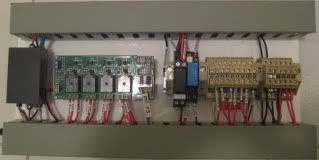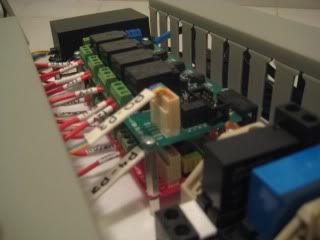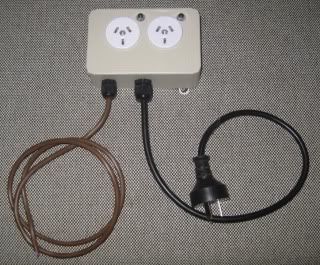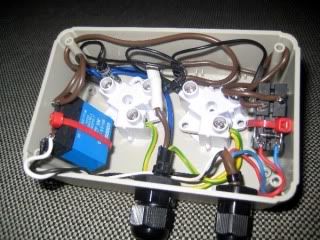@Bad_Inferno: Good point. Do you allready have failing CF cards?
The ballasts where 15$ each (using connections @ Philips Lightning). New and unused hehe... I calculate the light sequence using MySQL every night at 24:00 once for all lights for the upcomming day.
Results 91 to 96 of 96
-
Fri Jun 20, 2008, 06:11 PM #91Hi, I'm New Here!

- Join Date
- Oct 2007
- Posts
- 13
-
Fri Jun 20, 2008, 09:24 PM #92Medium Discus

- Join Date
- Jul 2004
- Location
- Eastern Suburbs... VIC
- Posts
- 671
I know there was some talk about this on the NSLU2/SLUG forums. I am not at the tech level to understand how to limit linux disk access. I am sure there is help on the net on using CF and limiting disk access on the linux distro you are using. I just use a small laptop drive.
Great job, that many lights you could create a DISCO sequence My online Aquarium www.rjconway.homeip.net
My online Aquarium www.rjconway.homeip.net
-
Sat Jun 21, 2008, 03:32 AM #93Larvae

- Join Date
- Feb 2007
- Location
- Canberra, ACT
- Posts
- 154
I know for the NSLU-2/Linux, there are some answers on how to reduce the amount of read/writes to your storage medium. It does also mention that you are better off using a HDD as opposed to flash memory as flash does not last as long with many read-write cycles. I think it is in their wiki or FAQ.
 $15 a piece for the ballasts !!
$15 a piece for the ballasts !!  I should be talking to you mate, buddy, pal, friend!!!!
I should be talking to you mate, buddy, pal, friend!!!! 
I did the same with my PIC based dimming system. It uses DS2890 100K Ohm digital pots (1-WIRE!!!). Only problem was, ballast dimming is logrithmic, digi pots are linear so I had to work out the correct value with a formula. It's somewhere else in this post.
I will eventually port all of the PIC based system over to a linux based set-up.
That's a good price on the dosing pumps. I eventually want to add these to my system as well. The plan is to use them to dose ferts about an hour before lights on so it has a good chance to mix with all the tank water.
Again, great work mate!Everybody sing with me.....
I owe, I owe, it's off to work I go.......
And no wonder why,
A 6 foot by 2 foot by 2 foot paradise for fish!
Eco-Complete substrate, CO2 injection, pH controller set at 6.7, Custom electronic lighting system and heating control made by the owner, ME!
Fish? oh yeah...
20 Neon's, 10 Cardinal's, 10 Rummy-Nose, 4 Headstanders, 4 Danio's, 2 Discus, 2 Congo's, 2 Clown's, 2 Bristlenose and 1 Siamese Algae Eater aka 'The Plant Mulcher' so far to date.
-
Sun Jan 10, 2010, 12:17 AM #94Medium Discus

- Join Date
- Jul 2004
- Location
- Eastern Suburbs... VIC
- Posts
- 671
This thread has been too quiet, what are people up to with respect to tank monitoring ? A lightning strike in December took out my telstra modem/router/ethernet port of my server and my 1wire network. So its taken a little while to get it back online its 90% back up and runsing.
Last year I did an update to the web interface. The gauges, for those that are a little web savy should be able to duplicate them as my code is documented.

www.rjconway.homeip.net
robMy online Aquarium www.rjconway.homeip.net
-
Tue Feb 09, 2010, 11:57 AM #95Medium Discus

- Join Date
- Jul 2004
- Location
- Eastern Suburbs... VIC
- Posts
- 671
Completed a new 8 channel relay mounted onto 4mm perspex plate. It looks alittle complicated however it really allows easy connection of the tank devices and also distributes the 12VDC power.
From Left to Right
1wire interface - Relay boards (double decker) ATO float relay and light actuator relay - terminals

You can see I had to mount the two relay boards ontop of one another

Under the 1wire controller I ahve mounted the refugium LED constant current power supply. This supply enables up to four 3W LED's to be driven.

AC Power Control
I required only two 1wire controlled AC powered devices. One being the main light the other the heater. I debated for quite a while in how best to acheive this in the safest way however deviced to simply use two good quality 12V relays inside a small box. These relays are controlled via the 1wire relay isolators on the main interface. above And yes there are now two relays controlling these outlets however all AC wiring is contained within the small box.
The heater needed to be normally ON thus without power to the relay the outlet is ON. That way if the controller fails the heater will be on, as it has its own thermostat, it will function as normal. The reason I wanted to be able to power off the heater was so that I can better regulate temperature on hot days. I did not want the heater fighting against the cooling fan when the tank temp was low. That way on hot days, ambient >26 I can just use fan control to regulate the tank temperature and turn off the heater.
The other outlet is simply the main light. Powering on the relay will turn the lights on.

 My online Aquarium www.rjconway.homeip.net
My online Aquarium www.rjconway.homeip.net
-
Thu Jun 17, 2010, 08:16 PM #96Hi, I'm New Here!

- Join Date
- Dec 2009
- Posts
- 4
Re: Cool.........
Where did you find the dosing pumps? Originally Posted by Gilles
Originally Posted by Gilles
How have they worked out for you?
ta



 Reply With Quote
Reply With Quote



